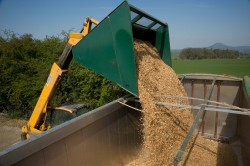 The handling, delivery and storage of woodfuel presents different challenges from more conventional, fossil fuels.
The handling, delivery and storage of woodfuel presents different challenges from more conventional, fossil fuels.
Key issues
There are two principal differences between the way a supply of biomass must be handled compared with mains gas:
- A sufficient reserve of biomass fuel must be stored at the point of usage
- Delivery must be arranged and scheduled.
Compared with heating oil, there is the fact that biomass is of significantly lower energy density and so a larger store is required.
Storing woodfuels
With high density modern housing, making space available for a fuel store is often not easy.
For a primary, pellet fired central heating system for a domestic house a fuel store of 10 m3 is recommended. This will allow the typical minimum bulk delivery of 5 tonnes of pellets to be received without having to be entirely empty first, and will require filling only once a year. For wood chips a considerably larger store will be required.
Delivery of biomass
It must also be easy to deliver fuel into the store. This typically requires both vehicular access and a convenient way to transfer the fuel from the delivery lorry into the store.
The simplest method is often tipping, and this may require either that the store is fully or partially underground, or that there is convenient ramp access. Wood pellets can be delivered pneumatically down a pipe, over distances of up to 30 m, from specially designed lorries, however these are not yet widespread in the UK.
Scheduling fuel deliveries, while familiar to users of oil or LPG, is a new consideration for those used to mains gas. Not only does this mean having to be aware of the level of fuel in the store and ensuring there will be a delivery before it runs out, but it also means having to identify a suitable local supplier.
